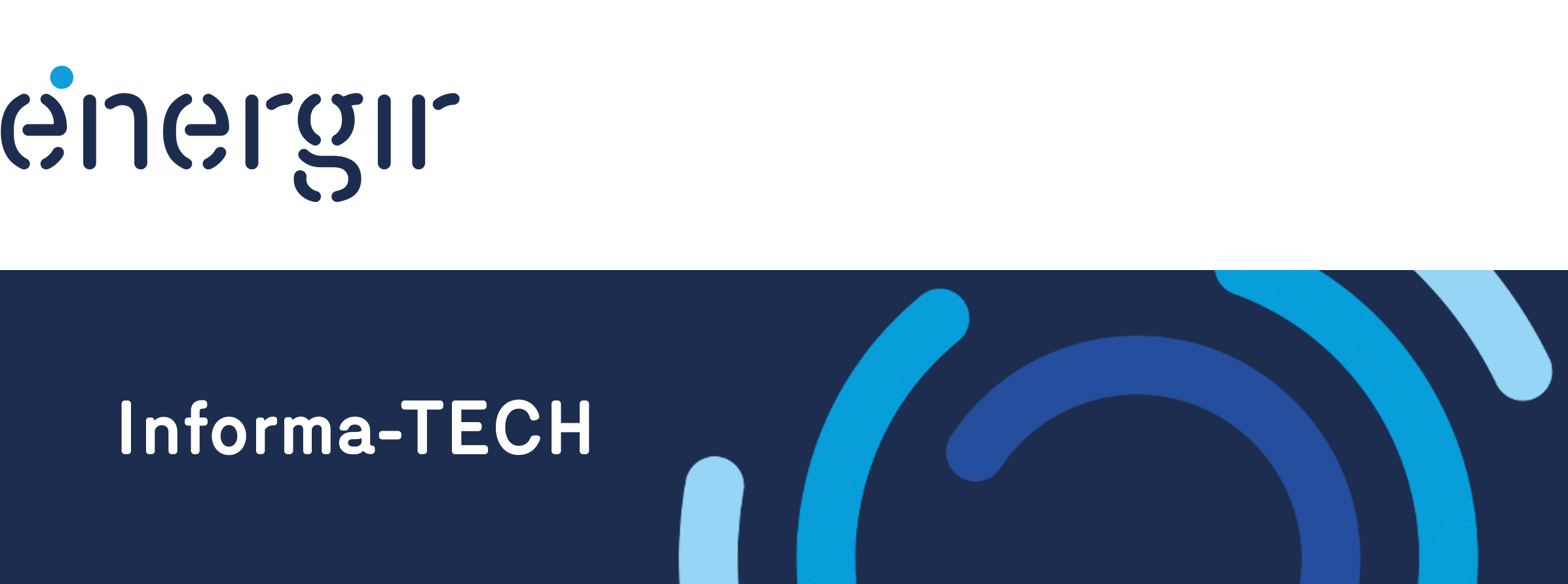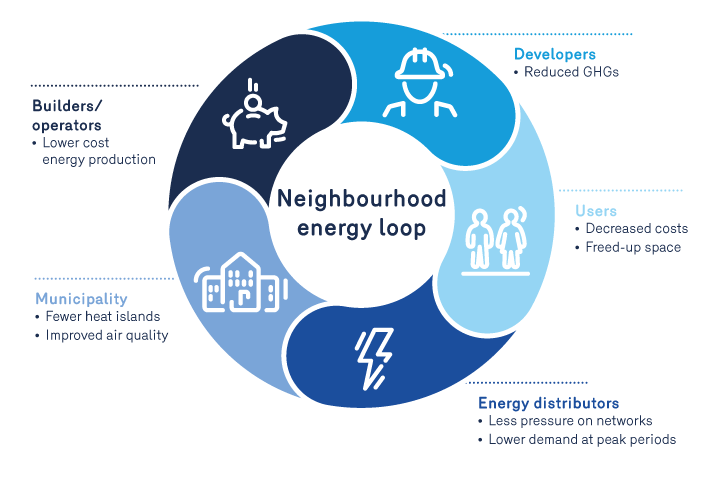Continue reading


Within the same neighbourhood, a thermal exchange loop acts like an energy distribution network, allocating the masses of hot and fresh air based on the needs of each space. Thus, in winter, the excess heat given off by a shopping centre, a plant or a data centre, may, for example, serve to heat a multi-residential complex which needs that heat. The hot or cold air discharged from a building becomes an input for the adjoining building. The loop includes a pumping centre, heat sources – primary, auxiliary or emergency – as well as decentralized heat pumps.
This pooling of energy presents economic and environmental advantages for each group involved in an energy loop project, and these advantages create a ‘’virtuous circle” from which each one benefits and in turn benefits others. The diagram below clearly illustrates this idea, which shows that all benefit when everyone puts their shoulder to the wheel.

An energy loop allows developers to considerably improve the energy efficiency of their project. In fact, it is estimated that it may result in a 40% reduction in overall energy consumption compared with the same project without a loop. This reduction in consumption is accompanied by a reduction in GHG emissions, which may reach 75%, according to the most recent studies. Also, the integration of an energy source such as renewable natural gas, air-source energy, or the recovery of heat from sewage, for example, may help achieve carbon neutrality.
In return, the energy and environmental performance leads to a more positive perception of the project, a fortiori if the developer obtains certification attesting to its energy and environmental performance, such as LEED certification, which then fosters the sale or rental of space by the target clientele. Also, by integrating local and renewable energy sources to an energy loop, either from the start or gradually, developers contribute directly to the economic development of their area.
Another notable advantage is that projects which call on an energy loop are eligible for several grants, which help to finance the project and shorten the payback period (ROI).
Better energy efficiency obviously translates into a reduction in energy bills for building owners and users. Also, the scalability of an energy loop facilitates the gradual integration of local renewable energies: vegetal biomass from sawmills or furniture-production plants, geothermal or solar energy, residual heat from industrial processes or data centres, etc. Over time, owners may thus benefit, in whole or in part, from clean, low-cost energy.
On the one hand, neighbourhood energy networks help assure the reliability of operations by avoiding any problems finding qualified workers to handle the complexity of the new equipment and the increased responsibilities related to maintaining certain components connected to the centralized HVAC system (water towers, refrigerants). On the other hand, centralizing the equipment helps reduce operating costs and frees up space that can be helpful, for example, in optimizing the use of the premises or the rental income. Also, recognized energy or environmental certification will have a positive effect on the rental or sale of the premises.
The reduction in energy consumption an energy loop offers helps mitigate the pressure put on distribution networks, particularly in peak periods, thus minimizing the risk of overloads and breakages. By reducing demand, energy loops may also lead to fewer costly energy imports and expenses related to upgrading distribution networks.
Municipalities are key players in the fight against GHG emissions and most have developed an action plan in this regard. Energy loops can contribute to the achievement of their GHG reduction targets and to an appreciable improvement in air quality for the benefit of all their citizens.
Reducing heat discharges into the atmosphere helps sustainably mitigate heat islands, a common problem in highly urbanized areas, which has direct consequences on the quality of life and the health of residents.
Energy loops also offer an economic benefit since they can use the biogas from the recovery of domestic waste and municipal sludge. Biomethanization plants, like those already in place in Saint-Hyacinthe, and soon in Québec City, can generate revenue and additional jobs for the municipalities and have a positive impact on GHG emissions, since the renewable natural gas produced is carbon neutral and 100% renewable. And, by reducing the quantity of waste landfilled or incinerated, municipalities can achieve significant savings while improving air quality.

The diversity of uses is a key element in any energy loop project. This diversity, combined with the energy loop’s heat storage capacity, creates a more uniform load profile that helps in heating and cooling more efficiently and economically. Builders and operators may thus reduce their costs and offer owners and renters attractive energy rates.
In addition, if the energy loop is in a zone where the electricity network is heavily loaded, operators may benefit from some financial assistance programs in return for a reduction in their power demand during peak periods. Lastly, builders can make their project cost-effective thanks to the various grants that are available (e.g., Énergir’s New efficient construction and the Innovation section of the Energy Efficiency Program, and many others), plus the sale of carbon credits.
Given their potential for reducing GHG emissions from heating and cooling, their low energy cost, their ability to improve air quality and to increase the use of renewable energies, thus reducing dependence on fossil energies while increasing the resilience of municipalities, make energy loops a desirable choice in the development of thermal energy networks in Québec.
And, while they demand rigorous planning and design, energy loops create a synergy that is beneficial to all the stakeholders, as well as to the population in general, by encouraging the diversity, density and efficiency of neighbourhoods, in tune with the sustainable development objectives pursued in Québec and around the world.
Continue reading
© 2024, Énergir